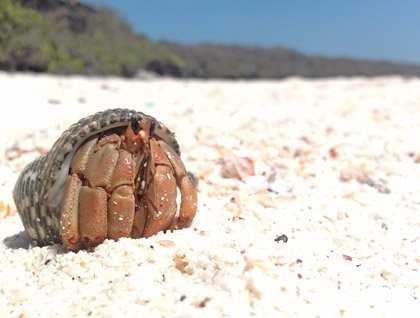There are times in life when enjoying an early morning rise with the sun makes one content. This morning kayakers started along the coast of Española as the sun started to rise above the cloud cover. Large Opuntia prickly pear cacti are visible along the cliffs of Española as the occasional pacific green sea turtle pops their head above the surface for a breath of air. The deep turquoise layers of water surround us as we return to our floating home after a spectacular kayak outing. After a flurry of obtaining snorkeling gear we are off again to snorkel from our Zodiacs along the coast of Gardner islet. Young Galapagos sea lions decide that we are somewhat odd in the water as they swim circles around us. Small diamond sting rays hover over the sandy bottom as they upturn the sandy bottom for small crustaceans as their meal. As we head for deeper water we encounter a kaleidoscope of invertebrates upon the islands wall that disappears into the abyss. Beach goers are able to watch the drama and comedy of life as sea lion pups lumber back and forth at the beach looking for their mothers who are most likely busy foraging for food offshore. As we return mid-day to the ship, an Española mockingbird is busily running between our legs searching for anything that may be of subsistence.
Navigation into the afternoon brings us to the only other National Park site on Española, Suarez Point. During this full moon the waves are slightly higher and the coast is awash in sea foam. As we start out on this hike over boulders most are surprised to find that the dense population of wildlife does not even move as we walk among them. Marine iguanas are brightly colored with bright green and red patterns upon their bodies and appear to be randomly placed along our path. Large Nazca boobies are perched along the southern cliffs and we find swallow tailed gulls and red billed tropic birds flying to and from their nesting areas. Mist is felt by some as the waves are compressed into a crack in the basalt coastline and vapor is shot up into the air. In the distance the open ocean has thousands of miles of its undulating movement until landfall. As the Sun dips in the distance, a pair of Galápagos hawks scan the land below them for nourishment and a light breeze cools us at last as we return from this settlement of life.







